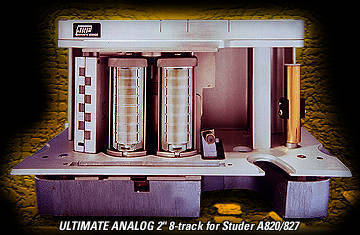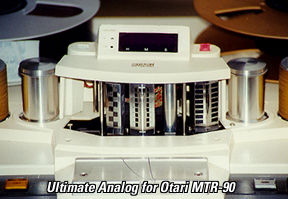 |
|
|
|
 |
|
|
 |
|
|
Whether tracking for music or mixing 5.1 Surround, Ultimate Analog MKII takes everything you like about analog recording and elevates it to a dramatically higher level of performance. Never before has a recording medium so successfully captured all the power, dynamics and delicate surrounding ambience ("air") of difficult-to-record musical instruments. Simply put, Ultimate Analog must be heard to be believed. |
|
- Output 10dB to 12dB hotter than standard 24-track recorded at same level
- Near-digital dynamic range and signal-to-noise ratios
- Outstanding performance even at 15 ips with no noise reduction
- Playback compatibility with standard 16- and 24-track formats
- Separate ninth time code track at track 24 position
- Installation requires no modifications and no mechanical calibration after initial set-up
- Available for Studer A800, A820, A827, A80 and Otari MTR-90
- JRF's guaranteed quality and service support
|
|
 |
|
|
|
Ultimate Analog from JRF was originally designed to record drums, bass and percussion instruments. In addition, our creative customers have found it to be a new and dynamic format for mixing and archiving 5.1 Surround projects. Users have described the results as "unbelievably fat," "in your face," and "bigger than life." (To put Ultimate Analog in perspective, imagine tracking on a stack of 1/2-inch 2-track heads.) The integrated time code track allows easy synchronizing for use in conjunction with any other analog or digital recording format–including one or two additional Ultimate Analog machines.
|
|
|
 |
|
|
|
 |
|
 |
|
|
|
The original inspiration behind Ultimate Analog came from noted producer Michael Beinhorn, whose credits include Social Distortion, Ozzy Osbourne, Aerosmith, Soundgarden and the Red Hot Chili Peppers. He wanted a sound that would combine the pleasing subjective characteristics of analog with the quietness and dynamic range of digital.
Beinhorn consulted with Fletcher at Mercenary Audio about the possibility of creating a 2-inch 8-track recording format. Mercenary then contacted John French of JRF Magnetic Sciences, who designed and manufactured the original UltraAnalog headstacks that were first introduced in 1995. In 1996, the format name was changed to Ultimate Analog, and the new MKII version was introduced. |
|
 |
|
|
|
|
Ultimate Analog MKII consists of three heads (erase, record and playback), each with eight wide-format audio tracks and a discrete time code track. The heads may be mounted on a customer's existing Studer A800/ A820/A827, A80, or Otari MTR-90 headblock, or fitted on a new (or reconditioned if available) headblock supplied by JRF. |
|
 |
|
The eight audio record/playback tracks are each 0.180 inches (4.6mm) wide, compared to 0.04 inch (1.Omm) on a standard 24-track machine. This extra width produces output levels 10dB to 12dB hotter than possible with a 24-track headstack under identical conditions. Higher output levels translate into lower noise, wider dynamic range, and the option to record with far less tape compression effect. However, when tape compression effects are desired, Ultimate Analog may be pushed far beyond conventional limits without oversaturation or distortion.
The eight tracks occupy the same portion of the head as tracks 1-22 on a standard 24-track head, Should playback ever be required on a standard 16-or 24-track machine, each of the eight tracks fully covers at least one track on both formats.
Ultimate Analog tracks one through eight are wired to the corresponding channels of the multitrack. The separate, ninth time code track is placed in the standard "track 24" position and wired to the headblock connector pins as track 24. Since the time code track is integrated into each head, no separate time code heads are utilized and the system functions as if it were a 24-track. Installation of an Ultimate Analog headblock requires no changes to existing multitrack or studio cabling, and machine calibration is "by the book." |
|
|
 |
|
|
 |
|
|
|
|
|
|
|
|
|
|
|
|
|


